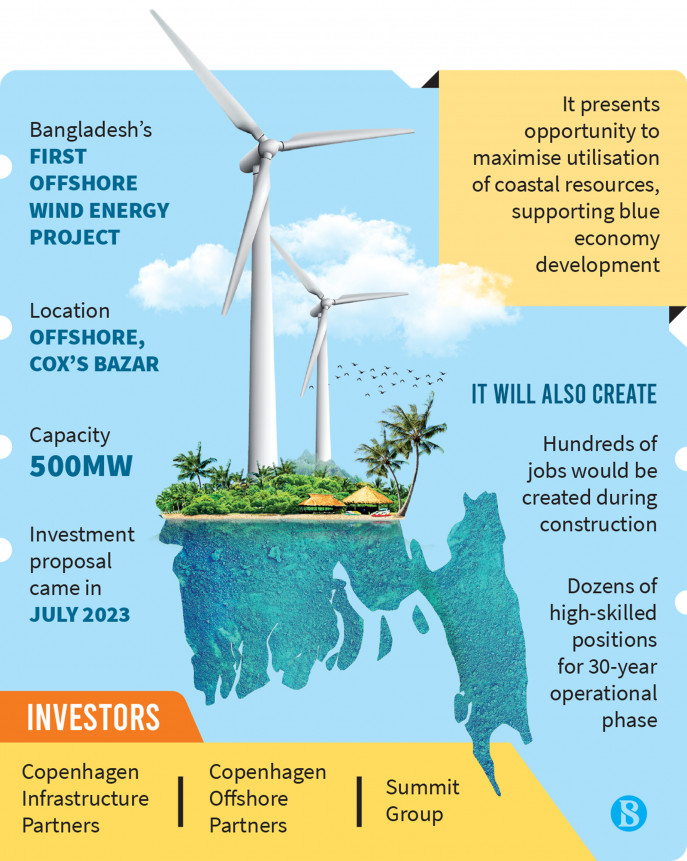Bilal9
ELITE MEMBER

- Joined
- Feb 4, 2014
- Messages
- 26,569
- Reaction score
- 9
- Country
- Location
Danish firms team up with Summit Power for the 500MW offshore wind power plant

Denmark's green investment proposal worth $1.3 billion for developing Bangladesh's first offshore 500MW wind energy project has secured government approval to advance to a comprehensive feasibility study, marking a significant stride in the nation's transition towards sustainable energy.
The approval came after the Copenhagen Infrastructure Partners (CIP) and Copenhagen Offshore Partners (COP) in association with Bangladesh's power giant Summit Group submitted the foreign direct investment proposal in July this year.
Once operational, the 500MW wind energy project will contribute to the national grid by supplying electricity directly through an onshore substation to residences and commercial establishments, bolstering Bangladesh's green energy infrastructure.
"We have given approval to the consortium to carry out a detailed feasibility study. Based on the results of the study, the next course of actions will be determined," Habibur Rahman, senior secretary of the Power Division, told The Business Standard on Sunday.
This wind project located in the offshore of Cox's Bazar presents a unique opportunity for the country to maximise the utilisation of its coastal resources, supporting the development of the blue economy.
With the Institute for Energy Economics and Financial Analysis (IEEFA) projecting an annual requirement of $1.7 billion in funding for the green transition, this multibillion-dollar initiative may kickstart a new wave of foreign and domestic investments, driving Bangladesh towards a truly climate prosperous future, insiders believe.
Once implemented, this offshore wind project will be the first of its kind in Bangladesh – and possibly in South Asia, enabling a technology transfer that would accelerate the learning curve for a nascent industry and reduce technological barriers to entry for future projects, said Md Mozammel Hossain, managing director of Summit Power Limited.
He said they got the approval from the authorities in the last week of October. On how long it may take and how much it may cost to carry out the study, he said such matters take time – two to three years – as the study has to be done in the sea. The cost of the study will be borne by the consortium, he noted.
On Summit's stakes in the project, he said it has not yet been finalised.
Mozammel said earlier the consortium carried out a preliminary study and based on those findings they have decided to conduct a detailed study.
Preliminary findings suggest that hundreds of direct and indirect jobs would be created during the construction phase, in addition to dozens of high-skilled permanent positions for the 30-year operational phase of the project.
According to a World Bank study, as a highly climate-vulnerable nation, Bangladesh's annual gross domestic product (GDP) could fall by as much as 9% by the middle of this century due to climate change. Bangladesh, therefore, needs to adapt rapidly to climate change, while simultaneously accessing cleaner, more efficient technologies that support decades of development and growth, a shift away from unstable fossil fuel imports, and limiting emissions as the country aims to achieve high-income status and elimination of absolute poverty by 2041.
In June this year, Bangladesh and Denmark approved a Joint Action Plan for the next five years under the "2022 Sustainable and Green Framework Engagement".
During a recent Dhaka visit, Danish Minister for Development Cooperation and Global Climate Policy Dan Jørgensen agreed to a partnership in green and clean technologies and investment for sustainable development.
The potential of wind energy is limited to coastal areas, offshore islands, riversides and other inland open areas with strong wind regimes. The Power Division and the Bangladesh Power Development Board have primarily identified 22 potential sites for Wind Resource Mapping in Bangladesh. Wind monitoring stations will be installed at these sites for comprehensive Wind Resource Assessment.
The BPDB has also planned to expand onshore wind power plants along the coastline of Bangladesh.
Bangladesh's electricity generation capacity stands at 25,339MW, with the government aiming to get 10% of its electricity from renewable sources, including solar, hydro, and wind, by 2025. Currently, the country has around 2% of its electricity generation capacity from renewable sources. Achieving the Sustainable Development Goals, or SDGs, requires Bangladesh at least 12% of electricity from these sources.








